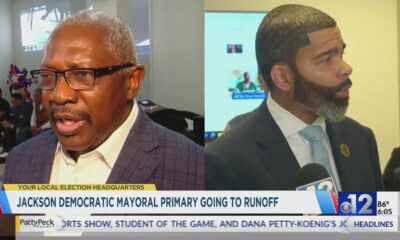Mississippi Today
How three Mississippi school districts are spending $207 million in federal relief funds
How three Mississippi school districts are spending $207 million in federal relief funds
Flush with $2.3 billion in federal pandemic relief funds, school districts across the state are working to spend them on infrastructure improvements, technology, and catching up on learning lost in the pandemic.
The Elementary and Secondary School Emergency Relief (ESSER) Fund was created initially by the Coronavirus Aid Relief and Economic Security (CARES) Act and then subsequently replenished in two other pieces of federal legislation, creating three separate pots of money for the state and districts to spend.
READ MORE: How much pandemic relief funds has your school district spent?
Mississippi Today reviewed the spending plans and spoke to local officials in three school districts which collectively received roughly $207 million: the Jackson Public School District, Ocean Springs School District, and Starkville-Oktibbeha Consolidated School District. Across the districts, the major spending themes are reopening schools safely, learning loss recovery, and infrastructure improvements.
A national analysis of district spending plans by FutureEd, an education policy think tank at Georgetown University, found that districts with higher poverty levels are receiving significantly more ESSER dollars per student, nearly 10 times more when comparing the highest and lowest poverty districts. FutureEd said this difference stems from Congress allocating the funds using the Title I funding formula, which distributes federal funding to schools based on the number of low-income students enrolled.
FutureEd also found that the higher the poverty rate in a district, the more likely administrators were to allocate money to heating, venting, and air conditioning (HVAC) updates and purchasing new instructional materials.
For example, in the Jackson Public School District, every school is budgeted to receive HVAC renovations, which are also often accompanied by window replacements or roof repairs. Chief of Staff William Merritt explained that these additional repairs are necessary to ensure that the new HVAC systems can run effectively.
Merritt said it would have been ideal to be allowed to use the federal dollars for building new facilities, since the district’s aging infrastructure means that repairing one problem often means finding another, but “that’s something that we can’t necessarily do at this time,” referencing the federal regulations that limit new construction.
Statewide, districts are using, on average, nearly half of their money from the third and largest pot of federal dollars on infrastructure. Most of it has gone to HVAC upgrades, buses, outdoor learning spaces, bathroom upgrades, technology, and new floors.
All three of the districts Mississippi Today spoke to are investing in HVAC upgrades. Leaders said these upgrades are a good preventative measure against airborne diseases like COVID-19, and a needed long-term investment because many buildings have outdated units.
District leaders also explained that the influx of federal dollars has created a supply and demand problem for contractors and parts. Coupled with the national supply chain issues, upgrades have been more costly in some cases and districts are pressured to get all of their projects done on time.
National leaders have recognized this pressure, giving states the ability to apply for extensions up to 14 months past the original deadlines. Since the funding came in waves, the spending deadlines do as well. The deadlines to have the money obligated for each pot are Sept. 30 of 2022, 2023, and 2024, but a grace period is built in that gives schools a few extra months to disperse final payments. Per the new extension option that is available, these initial deadlines to award contracts will still be in place, but the grace period to make payments on those contracts has been extended.
The Mississippi Department of Education confirmed that they are applying for an extension on the first round of federal funding.
The first pot of money, which districts began receiving in the summer of 2020, was targeted to reopening schools. It was used to make a significant investment in sanitation, initially meeting the immediate need for masks and cleaning supplies, later purchasing disinfectant sprayers with additional funding.
Anna Guntharp, assistant superintendent in the Starkville-Oktibbeha Consolidated School District, said that initial emphasis on personal protective equipment came from Centers for Disease Control and Prevention guidance, but that they have found it to be a good practice to keep generally even as public understanding about how COVID spreads has changed.
“There’s always a risk of transmitting viruses of any kind in a school,” Guntharp said. “Going forward, during flu season or even common cold season, we want to keep our kids safe. I think it was still money well spent even post COVID-19.”
Reopening efforts also included significant purchases of technology. The push to get each student a device saw significant support from the Legislature and Mississippi Department of Education, but districts also spent millions on laptops, tablets, video conferencing cameras, improving broadband connectivity, licensing virtual learning programs, and digital textbooks.
This investment in technology has long-lasting benefits for the students in the Jackson Public School District, according to Merritt, the chief of staff. The district, which often struggles with school closures caused by water pressure issues, will now be able to pivot to virtual instruction for other circumstances outside of a spike in disease transmission to avoid lost school days.
Extending instructional time is a key tactic to addressing the national decline in student achievement since 2019, frequently referred to as pandemic learning loss. This decline is one of the major focuses of the federal funding, with Congress creating a requirement for the third and largest pot of money that at least 20% must be spent addressing learning loss.
Districts are primarily pursuing two methods to address this decline: interventionists to work directly with students on concepts they’re struggling with in their larger classes, and after school and summer school programs to increase classroom hours.
Tonya Bolton, director of federal programs for the Ocean Springs School District, said the district has been analyzing data for each school to determine individualized areas of need, focusing on concepts from earlier grades that students may have missed and getting them up to grade level. Bolton said internal data shows their efforts have been effective enough that they may continue to invest money in having interventionists even after the federal funding runs out.
Guntharp said approximately 14% of students in the Starkville-Oktibbeha School District are currently working with interventionists, and the district is also looking for ways to afford retaining the ones they hired after the district runs out of federal funds.
Laura Anderson, associate director of the Edunomics Lab, said increased per-student spending doesn’t always lead to better outcomes, which makes it crucial for districts to constantly evaluate the effectiveness of their learning loss recovery plans – a sentiment education researchers have also echoed in recent reports on district level learning loss.
“We have this infusion (of money); what are our kids getting for it?” Anderson asked. “And if we don’t think that we’re getting the results that we wanted for our kids, how do we pivot? Districts have to be told it’s okay to be nimble and to make those changes.”
This article first appeared on Mississippi Today and is republished here under a Creative Commons license.
Mississippi Today
Early voting proposal killed on last day of Mississippi legislative session
Mississippi will remain one of only three states without no-excuse early voting or no-excuse absentee voting.
Senate leaders, on the last day of their regular 2025 session, decided not to send a bill to Gov. Tate Reeves that would have expanded pre-Election Day voting options. The governor has been vocally opposed to early voting in Mississippi, and would likely have vetoed the measure.
The House and Senate this week overwhelmingly voted for legislation that established a watered-down version of early voting. The proposal would have required voters to go to a circuit clerk’s office and verify their identity with a photo ID.
The proposal also listed broad excuses that would have allowed many voters an opportunity to cast early ballots.
The measure passed the House unanimously and the Senate approved it 42-7. However, Sen. Jeff Tate, a Republican from Meridian who strongly opposes early voting, held the bill on a procedural motion.
Senate Elections Chairman Jeremy England chose not to dispose of Tate’s motion on Thursday morning, the last day the Senate was in session. This killed the bill and prevented it from going to the governor.
England, a Republican from Vancleave, told reporters he decided to kill the legislation because he believed some of its language needed tweaking.
The other reality is that Republican Gov. Tate Reeves strongly opposes early voting proposals and even attacked England on social media for advancing the proposal out of the Senate chamber.
England said he received word “through some sources” that Reeves would veto the measure.
“I’m not done working on it, though,” England said.
Although Mississippi does not have no-excuse early voting or no-excuse absentee voting, it does have absentee voting.
To vote by absentee, a voter must meet one of around a dozen legal excuses, such as temporarily living outside of their county or being over 65. Mississippi law doesn’t allow people to vote by absentee purely out of convenience or choice.
Several conservative states, such as Texas, Louisiana, Arkansas and Florida, have an in-person early voting system. The Republican National Committee in 2023 urged Republican voters to cast an early ballot in states that have early voting procedures.
Yet some Republican leaders in Mississippi have ardently opposed early voting legislation over concerns that it undermines election security.
This article first appeared on Mississippi Today and is republished here under a Creative Commons license.
.
Mississippi Today
Mississippi Legislature approves DEI ban after heated debate
Mississippi lawmakers have reached an agreement to ban diversity, equity and inclusion programs and a list of “divisive concepts” from public schools across the state education system, following the lead of numerous other Republican-controlled states and President Donald Trump’s administration.
House and Senate lawmakers approved a compromise bill in votes on Tuesday and Wednesday. It will likely head to Republican Gov. Tate Reeves for his signature after it clears a procedural motion.
The agreement between the Republican-dominated chambers followed hours of heated debate in which Democrats, almost all of whom are Black, excoriated the legislation as a setback in the long struggle to make Mississippi a fairer place for minorities. They also said the bill could bog universities down with costly legal fights and erode academic freedom.
Democratic Rep. Bryant Clark, who seldom addresses the entire House chamber from the podium during debates, rose to speak out against the bill on Tuesday. He is the son of the late Robert Clark, the first Black Mississippian elected to the state Legislature since the 1800s and the first Black Mississippian to serve as speaker pro tempore and preside over the House chamber since Reconstruction.
“We are better than this, and all of you know that we don’t need this with Mississippi history,” Clark said. “We should be the ones that say, ‘listen, we may be from Mississippi, we may have a dark past, but you know what, we’re going to be the first to stand up this time and say there is nothing wrong with DEI.'”
Legislative Republicans argued that the measure — which will apply to all public schools from the K-12 level through universities — will elevate merit in education and remove a list of so-called “divisive concepts” from academic settings. More broadly, conservative critics of DEI say the programs divide people into categories of victims and oppressors and infuse left-wing ideology into campus life.
“We are a diverse state. Nowhere in here are we trying to wipe that out,” said Republican Sen. Tyler McCaughn, one of the bill’s authors. “We’re just trying to change the focus back to that of excellence.”
The House and Senate initially passed proposals that differed in who they would impact, what activities they would regulate and how they aim to reshape the inner workings of the state’s education system. Some House leaders wanted the bill to be “semi-vague” in its language and wanted to create a process for withholding state funds based on complaints that almost anyone could lodge. The Senate wanted to pair a DEI ban with a task force to study inefficiencies in the higher education system, a provision the upper chamber later agreed to scrap.
The concepts that will be rooted out from curricula include the idea that gender identity can be a “subjective sense of self, disconnected from biological reality.” The move reflects another effort to align with the Trump administration, which has declared via executive order that there are only two sexes.
The House and Senate disagreed on how to enforce the measure but ultimately settled on an agreement that would empower students, parents of minor students, faculty members and contractors to sue schools for violating the law.
People could only sue after they go through an internal campus review process and a 25-day period when schools could fix the alleged violation. Republican Rep. Joey Hood, one of the House negotiators, said that was a compromise between the chambers. The House wanted to make it possible for almost anyone to file lawsuits over the DEI ban, while Senate negotiators initially bristled at the idea of fast-tracking internal campus disputes to the legal system.
The House ultimately held firm in its position to create a private cause of action, or the right to sue, but it agreed to give schools the ability to conduct an investigative process and potentially resolve the alleged violation before letting people sue in chancery courts.
“You have to go through the administrative process,” said Republican Sen. Nicole Boyd, one of the bill’s lead authors. “Because the whole idea is that, if there is a violation, the school needs to cure the violation. That’s what the purpose is. It’s not to create litigation, it’s to cure violations.”
If people disagree with the findings from that process, they could also ask the attorney general’s office to sue on their behalf.
Under the new law, Mississippi could withhold state funds from schools that don’t comply. Schools would be required to compile reports on all complaints filed in response to the new law.
Trump promised in his 2024 campaign to eliminate DEI in the federal government. One of the first executive orders he signed did that. Some Mississippi lawmakers introduced bills in the 2024 session to restrict DEI, but the proposals never made it out of committee. With the national headwinds at their backs and several other laws in Republican-led states to use as models, Mississippi lawmakers made plans to introduce anti-DEI legislation.
The policy debate also unfolded amid the early stages of a potential Republican primary matchup in the 2027 governor’s race between State Auditor Shad White and Lt. Gov. Delbert Hosemann. White, who has been one of the state’s loudest advocates for banning DEI, had branded Hosemann in the months before the 2025 session “DEI Delbert,” claiming the Senate leader has stood in the way of DEI restrictions passing the Legislature.
During the first Senate floor debate over the chamber’s DEI legislation during this year’s legislative session, Hosemann seemed to be conscious of these political attacks. He walked over to staff members and asked how many people were watching the debate live on YouTube.
As the DEI debate cleared one of its final hurdles Wednesday afternoon, the House and Senate remained at loggerheads over the state budget amid Republican infighting. It appeared likely the Legislature would end its session Wednesday or Thursday without passing a $7 billion budget to fund state agencies, potentially threatening a government shutdown.
“It is my understanding that we don’t have a budget and will likely leave here without a budget. But this piece of legislation …which I don’t think remedies any of Mississippi’s issues, this has become one of the top priorities that we had to get done,” said Democratic Sen. Rod Hickman. “I just want to say, if we put that much work into everything else we did, Mississippi might be a much better place.”
This article first appeared on Mississippi Today and is republished here under a Creative Commons license.
Mississippi Today
House gives Senate 5 p.m. deadline to come to table, or legislative session ends with no state budget
The House on Wednesday attempted one final time to revive negotiations between it and the Senate over passing a state budget.
Otherwise, the two Republican-led chambers will likely end their session without funding government services for the next fiscal year and potentially jeopardize state agencies.
The House on Wednesday unanimously passed a measure to extend the legislative session and revive budget bills that had died on legislative deadlines last weekend.
House Speaker Jason White said he did not have any prior commitment that the Senate would agree to the proposal, but he wanted to extend one last offer to pass the budget. White, a Republican from West, said if he did not hear from the Senate by 5 p.m. on Wednesday, his chamber would end its regular session.
“The ball is in their court,” White said of the Senate. “Every indication has been that they would not agree to extend the deadlines for purposes of doing the budget. I don’t know why that is. We did it last year, and we’ve done it most years.”
But it did not appear likely Wednesday afternoon that the Senate would comply.
The Mississippi Legislature has not left Jackson without setting at least most of the state budget since 2009, when then Gov. Haley Barbour had to force them back to set one to avoid a government shutdown.
The House measure to extend the session is now before the Senate for consideration. To pass, it would require a two-thirds majority vote of senators. But that might prove impossible. Numerous senators on both sides of the aisle vowed to vote against extending the current session, and Lt. Gov. Delbert Hosemann who oversees the chamber said such an extension likely couldn’t pass.
Senate leadership seemed surprised at the news that the House passed the resolution to negotiate a budget, and several senators earlier on Wednesday made passing references to ending the session without passing a budget.
“We’ll look at it after it passes the full House,” Senate President Pro Tempore Dean Kirby said.
The House and Senate, each having a Republican supermajority, have fought over many issues since the legislative session began early January.
But the battle over a tax overhaul plan, including elimination of the state individual income tax, appeared to cause a major rift. Lawmakers did pass a tax overhaul, which the governor has signed into law, but Senate leaders cried foul over how it passed, with the House seizing on typos in the Senate’s proposal that accidentally resembled the House’s more aggressive elimination plan.
The Senate had urged caution in eliminating the income tax, and had economic growth triggers that would have likely phased in the elimination over many years. But the typos essentially negated the triggers, and the House and governor ran with it.
The two chambers have also recently fought over the budget. White said he communicated directly with Senate leaders that the House would stand firm on not passing a budget late in the session.
But Senate leaders said they had trouble getting the House to meet with them to haggle out the final budget.
On the normally scheduled “conference weekend” with a deadline to agree to a budget last Saturday, the House did not show, taking the weekend off. This angered Hosemann and the Senate. All the budget bills died, requiring a vote to extend the session, or the governor forcing them into a special session.
If the Legislature ends its regular session without adopting a budget, the only option to fund state agencies before their budgets expire on June 30 is for Gov. Tate Reeves to call lawmakers back into a special session later.
“There really isn’t any other option (than the governor calling a special session),” Lt. Gov. Delbert Hosemann previously said.
If Reeves calls a special session, he gets to set the Legislature’s agenda. A special session call gives an otherwise constitutionally weak Mississippi governor more power over the Legislature.
This article first appeared on Mississippi Today and is republished here under a Creative Commons license.
-

 Mississippi Today2 days ago
Mississippi Today2 days agoPharmacy benefit manager reform likely dead
-

 News from the South - Virginia News Feed7 days ago
News from the South - Virginia News Feed7 days agoYoungkin removes Ellis, appoints Cuccinelli to UVa board | Virginia
-

 News from the South - Oklahoma News Feed6 days ago
News from the South - Oklahoma News Feed6 days agoTornado watch, severe thunderstorm warnings issued for Oklahoma
-

 News from the South - Alabama News Feed7 days ago
News from the South - Alabama News Feed7 days agoUniversity of Alabama student detained by ICE moved to Louisiana
-

 News from the South - Georgia News Feed6 days ago
News from the South - Georgia News Feed6 days agoGeorgia road project forcing homeowners out | FOX 5 News
-

 News from the South - West Virginia News Feed6 days ago
News from the South - West Virginia News Feed6 days agoHometown Hero | Restaurant owner serves up hope
-

 News from the South - Kentucky News Feed4 days ago
News from the South - Kentucky News Feed4 days agoTornado practically rips Bullitt County barn in half with man, several animals inside
-

 News from the South - Georgia News Feed7 days ago
News from the South - Georgia News Feed7 days agoBudget cuts: Senior Citizens Inc. and other non-profits worry for the future

















































